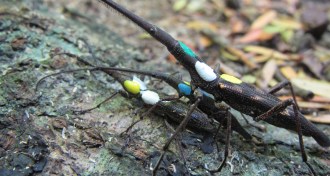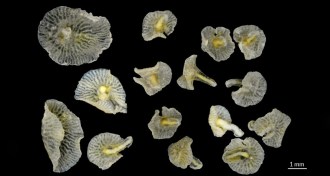Notebook
-
 Astronomy
AstronomyA musician composes a solar soundtrack
Robert Alexander combines life long passions of both music and astronomy to uncover solar secrets.
-
 Particle Physics
Particle PhysicsNew particle could help physicists understand subatomic glue
A newfound particle will allow scientists to probe the universe’s strongest force.
By Andrew Grant -
 Chemistry
ChemistryCrystallography celebrates centennial
Dubbed the international year of crystallography, 2014 marks the centennial of X-ray diffraction.
By Beth Mole -
 Health & Medicine
Health & MedicineStill waiting on a cure for diabetes
Diabetes diagnoses have skyrocketed in the past 50 years. While there are now better medications and options for control, there is still only hope of a cure.
-
 Animals
AnimalsSneaky little giraffe weevils beat big rivals
A little stealth gives smaller giraffe weevil males a leg up when competing with big ones for mates.
By Susan Milius -
 Astronomy
AstronomyWater found on Neptune-sized world
Just four times as wide as Earth, HAT-P-11b is the smallest exoplanet known to store water in its atmosphere.
-
 Tech
TechLong after JFK assassination, gunshot forensics still limited
The Warren Commission Report included the results of a neutron activation analysis test of Lee Harvey Oswald. But even that high-tech analysis can't distinguish the type of weapon fired.
-
 Health & Medicine
Health & MedicineSleep drunkenness might be common
A new survey shows that about 15 percent of people sometimes wake up disoriented and confused, a condition called sleep drunkenness.
-
 Animals
AnimalsMystery mushroomlike sea creatures get names
Specimens of a mushroomlike animal from the sea now have a scientific name, but researchers aren’t sure what kind of animal they are.
By Susan Milius -
 Genetics
GeneticsMolecular biologist honors ancient bones
After deciphering an ancient skeleton’s genetic secrets, molecular biologist Sarah Anzick helped reinter the remains.
-
 Tech
TechSpace tourism’s price tag rockets upward
The “high price” of space tourism proposed in the 1960s is nowhere close to the astronomical price tag of trips today.
By Nsikan Akpan -
 Earth
EarthDeath Valley’s sailing stones caught on the move
Mysterious sailing stones wandering around Death Valley are powered by ice and wind.